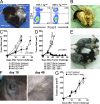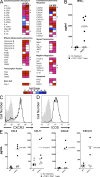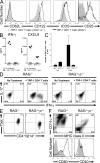Naive tumor-specific CD4(+) T cells differentiated in vivo eradicate established melanoma
- PMID: 20156973
- PMCID: PMC2839147
- DOI: 10.1084/jem.20091921
Naive tumor-specific CD4(+) T cells differentiated in vivo eradicate established melanoma
Abstract
In vitro differentiated CD8(+) T cells have been the primary focus of immunotherapy of cancer with little focus on CD4(+) T cells. Immunotherapy involving in vitro differentiated T cells given after lymphodepleting regimens significantly augments antitumor immunity in animals and human patients with cancer. However, the mechanisms by which lymphopenia augments adoptive cell therapy and the means of properly differentiating T cells in vitro are still emerging. We demonstrate that naive tumor/self-specific CD4(+) T cells naturally differentiated into T helper type 1 cytotoxic T cells in vivo and caused the regression of established tumors and depigmentation in lymphopenic hosts. Therapy was independent of vaccination, exogenous cytokine support, CD8(+), B, natural killer (NK), and NKT cells. Proper activation of CD4(+) T cells in vivo was important for tumor clearance, as naive tumor-specific CD4(+) T cells could not completely treat tumor in lymphopenic common gamma chain (gamma(c))-deficient hosts. gamma(c) signaling in the tumor-bearing host was important for survival and proper differentiation of adoptively transferred tumor-specific CD4(+) T cells. Thus, these data provide a platform for designing immunotherapies that incorporate tumor/self-reactive CD4(+) T cells.
Figures







Similar articles
-
Tumor-reactive CD4(+) T cells develop cytotoxic activity and eradicate large established melanoma after transfer into lymphopenic hosts.J Exp Med. 2010 Mar 15;207(3):637-50. doi: 10.1084/jem.20091918. Epub 2010 Feb 15. J Exp Med. 2010. PMID: 20156971 Free PMC article.
-
Increased frequency of suppressive regulatory T cells and T cell-mediated antigen loss results in murine melanoma recurrence.J Immunol. 2012 Jul 15;189(2):767-76. doi: 10.4049/jimmunol.1103822. Epub 2012 Jun 20. J Immunol. 2012. PMID: 22723522 Free PMC article.
-
Divergent roles for CD4+ T cells in the priming and effector/memory phases of adoptive immunotherapy.J Immunol. 2000 Oct 15;165(8):4246-53. doi: 10.4049/jimmunol.165.8.4246. J Immunol. 2000. PMID: 11035058
-
CD4 T-cell immunotherapy for chronic viral infections and cancer.Immunotherapy. 2013 Sep;5(9):975-87. doi: 10.2217/imt.13.91. Immunotherapy. 2013. PMID: 23998732 Free PMC article. Review.
-
Harnessing Antitumor CD4+ T Cells for Cancer Immunotherapy.Cancers (Basel). 2022 Jan 5;14(1):260. doi: 10.3390/cancers14010260. Cancers (Basel). 2022. PMID: 35008422 Free PMC article. Review.
Cited by
-
Tumor-specific CD4+ T cells eradicate myeloma cells genetically deficient in MHC class II display.Oncotarget. 2016 Oct 11;7(41):67175-67182. doi: 10.18632/oncotarget.11946. Oncotarget. 2016. PMID: 27626487 Free PMC article.
-
Cytotoxic chemotherapy and CD4+ effector T cells: an emerging alliance for durable antitumor effects.Clin Dev Immunol. 2012;2012:890178. doi: 10.1155/2012/890178. Epub 2012 Feb 6. Clin Dev Immunol. 2012. PMID: 22400040 Free PMC article. Review.
-
Isolation of human MHC class II-restricted T cell receptors from the autologous T-cell repertoire with potent anti-leukaemic reactivity.Immunology. 2012 Nov;137(3):226-38. doi: 10.1111/imm.12000. Immunology. 2012. PMID: 23025755 Free PMC article.
-
EBP1 protein modulates the expression of human MHC class II molecules in non-hematopoietic cancer cells.Int J Oncol. 2015 Aug;47(2):481-9. doi: 10.3892/ijo.2015.3051. Epub 2015 Jun 16. Int J Oncol. 2015. PMID: 26081906 Free PMC article.
-
Citrullinated α-enolase is an effective target for anti-cancer immunity.Oncoimmunology. 2017 Nov 6;7(2):e1390642. doi: 10.1080/2162402X.2017.1390642. eCollection 2018. Oncoimmunology. 2017. PMID: 29308319 Free PMC article.
References
-
- Antony P.A., Piccirillo C.A., Akpinarli A., Finkelstein S.E., Speiss P.J., Surman D.R., Palmer D.C., Chan C.C., Klebanoff C.A., Overwijk W.W., et al. 2005. CD8+ T cell immunity against a tumor/self-antigen is augmented by CD4+ T helper cells and hindered by naturally occurring T regulatory cells. J. Immunol. 174:2591–2601 - PMC - PubMed
-
- Behrens G.M., Li M., Davey G.M., Allison J., Flavell R.A., Carbone F.R., Heath W.R. 2004b. Helper requirements for generation of effector CTL to islet beta cell antigens. J. Immunol. 172:5420–5426 - PubMed
Publication types
MeSH terms
Substances
Grants and funding
LinkOut - more resources
Full Text Sources
Other Literature Sources
Medical
Molecular Biology Databases
Research Materials

